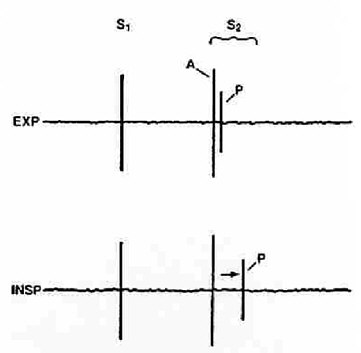
Physiological Splitting of the Second Sound
The second heart sound (S2) is actually the combined sound generated by closure of the aortic and pulmonary valves. The timing of individual valve closure is a function of ventilatory effort so that during the ventilatory cycle, the second heart sound may appear to be a single sound or alternatively two separate and distinct sounds.

During inspiration, venous filling of the right ventricle is augmented. Therefore, right ventricular systole requires a longer time period to empty its contents into the pulmonary artery. At the same time, a reduction in left ventricular filling allows for a very slight reduction in the time for LV ejection and an earlier time for the onset of aortic valve closure. The net result is a difference in time (usually greater than 25 msec., the limit of human hearing to distinguish separate sounds) that allows you to separately recognize aortic (first) and pulmonary (second) closure. It may often sound as though the second sound rather than a crisp sound becomes "dirty". In cadence speak, the "lub dup" becomes "lub ddrup". Additionally, splitting is most easily examined with the patient in the seated or standing position.
At the bedside, listening at the left upper sternal border (to better recognize pulmonary valve closure) note the character of the second heart sound during the second systole following ventilatory effort. Recognition of a reduplication of the second sound after ventilation with return to a "single" second sound on expiration is normal or "physiological" splitting of the second sound. With normal pulmonary artery pressures, the cadence should "decline" or give a "ta dup". With increased pulmonary artery pressures, the pulmonary closure sound will increase in amplitude giving the pair, when split, a rising (if you will) cadence or a "ta dap". In addition, audible splitting should gradually become inaudible as you "inch" toward the apex. Audible splitting at the apex is almost always a sign of pulmonary hypertension.
Return to Heart Sounds Podcast Series
Updated May 2010